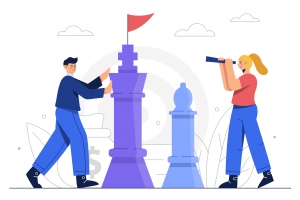How to Use Content Marketing to Drive Sales and Increase Revenue
In today's digital-first business environment, content marketing has become a crucial strategy for brands seeking to engage customers and drive sales. Content marketing involves creating valuable, relevant content to attract and retain a clearly defined audience—ultimately driving profitable customer actions. This article explores how you can leverage content marketing to not only boost your sales but also increase revenue, by focusing on audience engagement, SEO, lead generation, and content performance.
Understanding Your Audience
The first step in any successful content marketing strategy is understanding your target audience. Knowing who your audience is, what they care about, and how they make purchasing decisions is essential for creating content that resonates.
One way to achieve this is by developing buyer personas. Buyer personas are detailed descriptions of your ideal customers based on real data and research. They include information such as demographics, interests, buying behaviors, and pain points. For example, if you're marketing software to small business owners, you need to understand their unique challenges—such as limited resources or a need for efficiency—so you can tailor content that speaks directly to their needs.
Once you know your audience, you can identify their pain points and craft content that offers solutions. Whether you're offering a product demo, an explainer blog post, or a case study, the key is to provide real value that solves customer problems and encourages them to move forward in their buying journey.
Creating Valuable and Engaging Content
Content that provides value to the audience is essential for driving sales. People turn to brands not just for products but also for information and guidance. This is why creating problem-solving content is so effective. Articles, videos, and infographics that educate or offer solutions are likely to engage users and build trust.
Diversifying content formats is also important to ensure you reach various segments of your audience. While some may prefer to read blogs, others may engage more with visual content like videos or infographics. You can also repurpose your content by turning a blog post into a video or an infographic, thereby expanding its reach across different platforms.
Leveraging SEO for Content Visibility
Even the most valuable content won't drive sales if your target audience can't find it. This is where search engine optimization (SEO) comes in. By optimizing your content for search engines, you ensure that it ranks higher in search results and is visible to users who are actively looking for what you offer.
Keyword research is the foundation of SEO. By identifying relevant keywords—especially those that indicate buyer intent—you can optimize your content to appear in search results when potential customers are ready to make a purchase. For instance, instead of targeting general keywords like "marketing tools," use specific terms like "best marketing automation tools for small businesses."
Implementing on-page SEO techniques such as using appropriate meta descriptions, headers, and internal links also improves your content's visibility. Additionally, building backlinks through guest posting and outreach efforts can boost your domain authority, increasing the likelihood that your content will rank higher in search results.
Optimizing Content for Lead Generation
Driving traffic to your website is just one piece of the puzzle—once users arrive, you need to capture them as leads. This involves creating clear, compelling calls-to-action (CTAs) that guide visitors toward taking the next step, such as signing up for a newsletter, downloading a resource, or scheduling a demo.
Gated content is another effective strategy for generating leads. Offering valuable resources like eBooks, whitepapers, or webinars in exchange for a user's contact information allows you to build your email list while providing value to potential customers. Once you have their contact information, you can further engage them through email marketing, sending personalized content that nurtures leads until they're ready to make a purchase.
Nurturing Leads with Content
Content plays a critical role in nurturing leads throughout the buyer's journey. It's essential to create content tailored to each stage of the funnel—awareness, consideration, and decision.
For example, at the awareness stage, you might create educational blog posts or videos that introduce a problem and how your product can help solve it. At the consideration stage, more in-depth content such as case studies and product comparisons can help prospects evaluate their options. And at the decision stage, customer testimonials and product demos can build the trust needed to close the sale.
Retargeting content is also a powerful tool to bring leads back into the funnel. For instance, if a user visits your product page but doesn't make a purchase, you can use retargeting ads to serve them content that addresses their hesitations or offers a special discount.
Analyzing Content Performance
To continuously improve your content marketing efforts, it's essential to measure key performance metrics. Some of the most important metrics include website traffic, engagement (such as time on page and bounce rate), and conversion rates.
A/B testing is a great way to optimize your content by comparing different versions to see which performs better. For example, you could test different headlines, CTAs, or images to see which ones drive more conversions.
Using tools like Google Analytics or marketing platforms like HubSpot can help track your content's ROI, allowing you to make data-driven decisions and adjust your strategy accordingly.
Scaling Content Marketing for Continuous Growth
As your content marketing efforts begin to generate results, you can start scaling them to drive even more revenue. Automation tools such as Hootsuite or Buffer allow you to schedule and distribute content efficiently across multiple platforms.
Creating a content calendar ensures consistency and helps maintain momentum, keeping your audience engaged with regular updates. Additionally, leveraging collaborations and influencers can expand your content's reach by tapping into new audiences.
Conclusion
Content marketing is a powerful strategy for driving sales and increasing revenue. By understanding your audience, creating valuable content, optimizing for SEO, generating leads, and nurturing them through the buyer's journey, you can turn content into a consistent sales driver.
To effectively implement these strategies, investing in a comprehensive digital marketing course can be incredibly beneficial. Such a course will equip you with the knowledge and skills needed to master content marketing techniques, including audience targeting, SEO best practices, and performance analytics.
By understanding these key aspects, you can create more compelling content, optimize your marketing efforts, and drive better results for your business. Enrolling in a digital marketing course will provide you with the tools necessary to refine your strategy and achieve greater success in your content marketing efforts.






